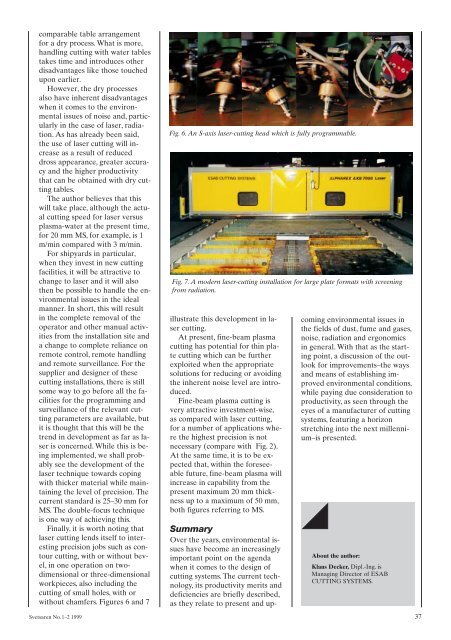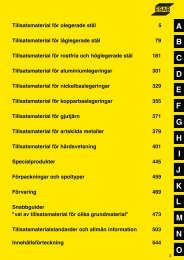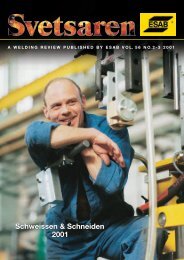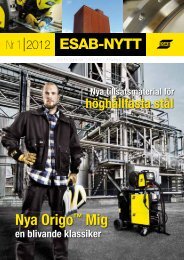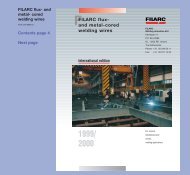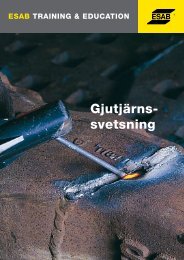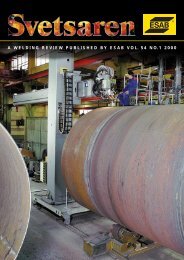undoubtedly a very costly solutionand one with reduced productivity.Another solution could be toadapt the process to water-plasmaoperation. This would call fora water table, an air muffleraround the torch and a largercutting power source to providethe increased energy that is neededfor under-water cutting. Alsoa solution which calls for high investmentsand has inherent featuresthat will reduce productivity.To the knowledge <strong>of</strong> the author,none <strong>of</strong> the solutions has s<strong>of</strong>ar actually been put into operation.Cutting speeds N 2 /O 2Cutting Speed N 2Plate thickness (mm)Cutting Speed O 2Fig. 5. Cutting speeds versus plate thickness for MS for water-plasma cutting withO 2 and N 2 respectively.Speed (m/min)Ergonomics in generalThe development <strong>of</strong> controls forCNC cutting has brought about ageneral improvement in ergonomics.Just consider the followingexamples – marking equipment,automatic nesting, automaticcutting bridges, colour monitorfacilities, automatic height control,flame control and monitoringby sensors and advanced programmingfacilities.In the case <strong>of</strong> cutting installations,ergonomic improvementsworth mentioning include automaticplate alignment, tables withtransport facilities for the outloading<strong>of</strong> parts and double tables,roller bed arrangements,special overhead cranes, specialarrangements for easy slag removal,all features that have helpedto reduce the heavy physicalwork and the man-hours used permetre cut.Development targetsProductivity in the broadest sense<strong>of</strong> the word is the driving forcewhen it comes to selecting the developmenttargets for the cuttingprocess as applied in cutting installations.This focuses attentionon the operations that are neededafter cutting, as a result <strong>of</strong> a moreor less perfect cutting performance.In plain terms, the answersto quality issues such as accuracy,freedom from dross,squareness and bevel quality.In the case <strong>of</strong> different cuttingprocesses, we find different combinations<strong>of</strong> answers to thesequality issues.At the present time, dross-freeand accurately-cut parts are basicallyregarded as the major targetsto aim for, because the cost associatedwith dross removal by postprocessingcut parts is considerable,as is the lack <strong>of</strong> precision forwelding operations that, more <strong>of</strong>tenthan not, follows after cutting.Another productivity issuewhich has a direct bearing on thenature <strong>of</strong> the cutting process isthe minimising <strong>of</strong> process downtimedue to wear to torch tips,electrodes and nozzles. Systemsfor monitoring, surveillance andfast and precise exchange modesare in demand for all processes.It is also relevant to mentionthe constant design attention thatmust be paid to the interactionbetween the aforementioned development<strong>of</strong> controls and thecorresponding electrical and mechanicaldesign <strong>of</strong> cutting machines,as regards their dynamicresponse to rapid movementswith up to five degrees <strong>of</strong> freedom.A very high degree <strong>of</strong> dynamicresponse is an absoluteprerequisite for realising the potentialadvantages <strong>of</strong>fered by anysophisticated cutting process.Finally, modern IT developments,utilised correctly with advancedsensor technology, havemade great advances in diagnosticsystems possible. This trendwill continue and lead to furtherimprovements relating to preventiveupkeep to minimise downtime,to secure fast troubleshootingand provide input for qualitysurveillance.Water plasmaIn order to reduce the post-processing<strong>of</strong> cut parts and also toobtain higher cutting speeds atreduced energy consumption, thereis a move towards cutting withoxygen, O 2 , instead <strong>of</strong> nitrogen,N 2 (Fig. 5).Investigations appear to indicatethat the running costs, interms <strong>of</strong> the consumption <strong>of</strong> gas,energy and consumables, end upat the same cost level, whereasthe use <strong>of</strong> O 2 improves the drossfreerange <strong>of</strong> plate thickness andpermits a 40% increase in cuttingspeed in 12 mm steel plate. forexample. As the energy that isneeded is lower as a result <strong>of</strong> theexothermic reactions with O 2 insteel, changing to O 2 increasesthe possible plate thickness for agiven size <strong>of</strong> power source.When it comes to the precisionand accuracy that can be obtained,it is likely that water-plasmacutting, no matter which gas isused, will lose its foothold tosome degree and laser cutting willbe preferred. In the case <strong>of</strong> newinstallations, it will be possible totake the special precautions thatare needed to operate a laser-cuttinginstallation, while paying dueconsideration to its environmentalimplications. This will be touchedupon at a later stage.Laser and dry plasmaThe dry processes have the inherentadvantage <strong>of</strong> being dry, whichmeans that they do not need awater table, a considerably moreexpensive arrangement than a36 <strong>Svetsaren</strong> No.1 1999
comparable table arrangementfor a dry process. What is more,handling cutting with water tablestakes time and introduces otherdisadvantages like those touchedupon earlier.However, the dry processesalso have inherent disadvantageswhen it comes to the environmentalissues <strong>of</strong> noise and, particularlyin the case <strong>of</strong> laser, radiation.As has already been said,the use <strong>of</strong> laser cutting will increaseas a result <strong>of</strong> reduceddross appearance, greater accuracyand the higher productivitythat can be obtained with dry cuttingtables.The author believes that thiswill take place, although the actualcutting speed for laser versusplasma-water at the present time,for 20 mm MS, for example, is 1m/min compared with 3 m/min.For shipyards in particular,when they invest in new cuttingfacilities, it will be attractive tochange to laser and it will alsothen be possible to handle the environmentalissues in the idealmanner. In short, this will resultin the complete removal <strong>of</strong> theoperator and other manual activitiesfrom the installation site anda change to complete reliance onremote control, remote handlingand remote surveillance. For thesupplier and designer <strong>of</strong> thesecutting installations, there is stillsome way to go before all the facilitiesfor the programming andsurveillance <strong>of</strong> the relevant cuttingparameters are available, butit is thought that this will be thetrend in development as far as laseris concerned. While this is beingimplemented, we shall probablysee the development <strong>of</strong> thelaser technique towards copingwith thicker material while maintainingthe level <strong>of</strong> precision. Thecurrent standard is 25–30 mm forMS. The double-focus techniqueis one way <strong>of</strong> achieving this.Finally, it is worth noting thatlaser cutting lends itself to interestingprecision jobs such as contourcutting, with or without bevel,in one operation on twodimensionalor three-dimensionalworkpieces, also including thecutting <strong>of</strong> small holes, with orwithout chamfers. Figures 6 and 7Fig. 6. An S-axis laser-cutting head which is fully programmable.Fig. 7. A modern laser-cutting installation for large plate formats with screeningfrom radiation.illustrate this development in lasercutting.At present, fine-beam plasmacutting has potential for thin platecutting which can be furtherexploited when the appropriatesolutions for reducing or avoidingthe inherent noise level are introduced.Fine-beam plasma cutting isvery attractive investment-wise,as compared with laser cutting,for a number <strong>of</strong> applications wherethe highest precision is notnecessary (compare with Fig. 2).At the same time, it is to be expectedthat, within the foreseeablefuture, fine-beam plasma willincrease in capability from thepresent maximum 20 mm thicknessup to a maximum <strong>of</strong> 50 mm,both figures referring to MS.SummaryOver the years, environmental issueshave become an increasinglyimportant point on the agendawhen it comes to the design <strong>of</strong>cutting systems. The current technology,its productivity merits anddeficiencies are briefly described,as they relate to present and upcomingenvironmental issues inthe fields <strong>of</strong> dust, fume and gases,noise, radiation and ergonomicsin general. With that as the startingpoint, a discussion <strong>of</strong> the outlookfor improvements–the waysand means <strong>of</strong> establishing improvedenvironmental conditions,while paying due consideration toproductivity, as seen through theeyes <strong>of</strong> a manufacturer <strong>of</strong> cuttingsystems, featuring a horizonstretching into the next millennium–ispresented.About the author:Klaus Decker, Dipl.-Ing. isManaging Director <strong>of</strong> ESABCUTTING SYSTEMS.<strong>Svetsaren</strong> No.1–2 1999 37


